- SEO rankings increasingly depend on user experience signals like intent resolution, engagement patterns, and Core Web Vitals performance.
- UX in SEO aligns information architecture, content presentation, and technical performance so users and search engines reach the same conclusions.
- Integrated UX and SEO strategies reduce ranking volatility, improve long-term visibility, and future-proof content for AI-driven and generative search.
UX in SEO has become one of the most decisive factors in modern organic search performance. Search engines no longer evaluate pages based solely on keywords or technical compliance; they assess how effectively a page satisfies user intent, reduces friction, and delivers value through experience.
Today, UX and SEO operate as a unified system. A page may rank because it appears relevant, but it stays ranked because users confirm that relevance through engagement, clarity, and usability. When marketers treat UX and SEO as separate disciplines, they create experiences that either rank briefly or convert poorly, often both.
This guide breaks down what UX in SEO actually means, how user experience directly influences rankings, and how marketers, designers, and growth teams can integrate UX design and SEO into a single performance strategy. If your goal is sustainable visibility, higher engagement, and stronger conversion from organic traffic, UX in SEO is no longer optional; it’s foundational.
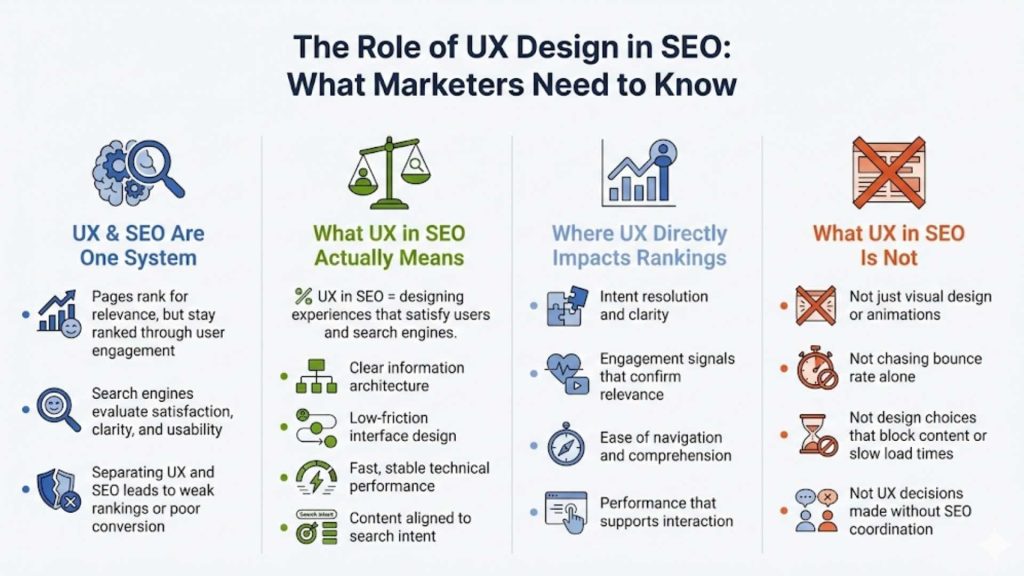
What Is UX in SEO? A Precise and Operational Definition
The question “what is ux in seo” deserves a definition grounded in execution, not abstraction. UX in SEO refers to the deliberate design of digital experiences that satisfy user intent while aligning with how search engines crawl, interpret, and rank content. It is not about visual design alone, nor is it limited to usability testing. It is about structuring every interaction so that users and algorithms reach the same conclusion about value.
UX in SEO encompasses multiple layers of experience:
- Information architecture that supports discoverability and comprehension
- Interface design that reduces friction and cognitive load
- Technical performance that enables fast, stable interactions
- Content presentation that aligns with search intent and user expectations
UX and SEO converge most clearly at the point of intent resolution. A page ranks because it appears relevant, but it stays ranked because users confirm that relevance through engagement. This is how UX impacts SEO in practice. When users interact positively with a page, search engines gain confidence that the result deserves visibility.
It is also important to clarify what UX in SEO is not. It is not simply reducing bounce rate, adding animations, or following generic usability heuristics. UX design and SEO require intentional coordination. A design decision that improves aesthetics but slows load time or obscures indexable content can actively harm organic performance.
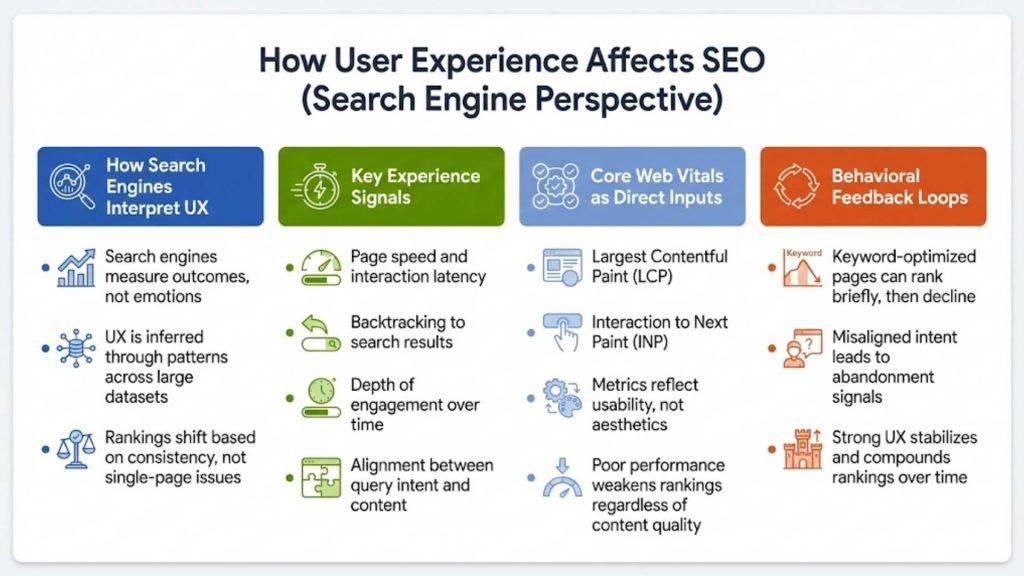
How User Experience Affects SEO from a Search Engine Perspective
Understanding how user experience affects SEO requires examining how search engines interpret experience signals at scale. Search engines cannot feel frustration or satisfaction, but they can measure outcomes that correlate with those states. Over time, these outcomes shape ranking behavior.
Experience Signals and Algorithmic Interpretation
Search engines rely on a mix of explicit and inferred signals to evaluate UX:
- Performance metrics such as loading speed and interaction latency
- Behavioral patterns like rapid backtracking to search results
Engagement depth across sessions and queries - Consistency between query intent and page content
These signals do not operate in isolation. A single slow page or high exit rate does not trigger penalties. Patterns across large datasets do. This is why user experience optimization must focus on systemic improvements rather than cosmetic fixes.
Core Web Vitals represent the most explicit example of UX becoming algorithmic input. Metrics like Largest Contentful Paint and Interaction to Next Paint directly reflect whether a user can access and use content efficiently. Poor performance here weakens rankings regardless of content quality.
Behavioral Feedback Loops
Behavioral data reinforces performance signals. When users repeatedly abandon a result or fail to engage meaningfully, search engines adjust their confidence in that page. This is where seo and ux intersect most visibly. A page optimized purely for keywords but misaligned with intent often ranks temporarily and then declines as behavior signals accumulate.
UX and SEO alignment reduces this volatility. When users find what they expect quickly and effortlessly, rankings stabilize and often improve over time. This relationship explains why optimized user experience has become a competitive advantage rather than a refinement.
UX Design and SEO at the Information Architecture Level
Information architecture is one of the most overlooked yet powerful connections between ux design and seo. It defines how content is organized, connected, and accessed across a site. Both users and search engines rely on this structure to form an understanding of relevance and authority.
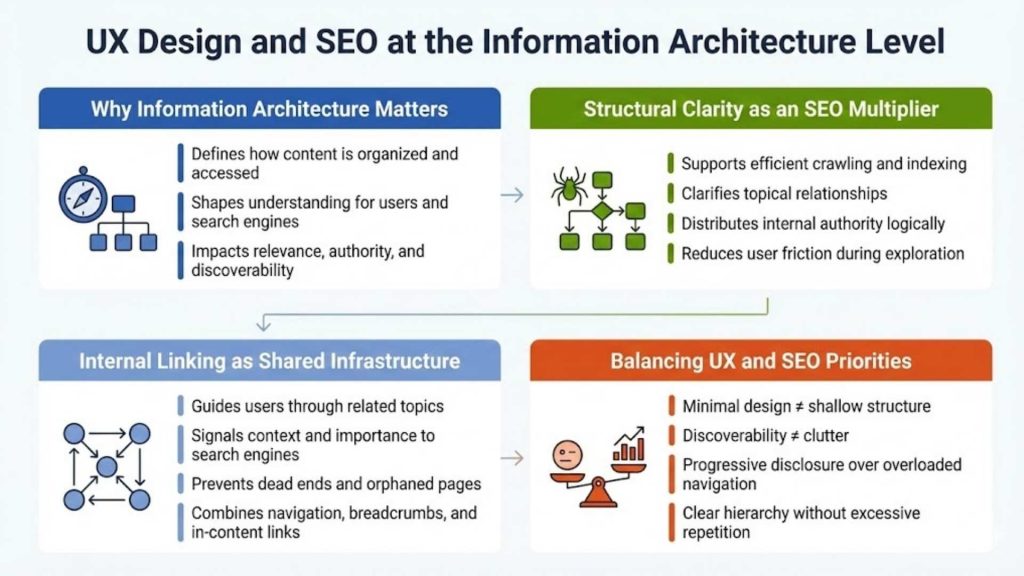
Structural Clarity as an SEO Multiplier
Strong information architecture supports SEO in several ways:
- It enables efficient crawling and indexing
- It clarifies topical relationships between pages
- It distributes internal authority logically
- It reduces user friction during exploration
From a UX perspective, architecture determines whether users feel oriented or lost. From an SEO perspective, it determines whether search engines can identify priority pages and thematic depth. When these perspectives align, performance compounds.
Internal Linking as UX and SEO Infrastructure
Internal linking sits at the intersection of seo ux design, helping users navigate related topics through contextual pathways that reinforce relevance. Links guide users through related content while signaling importance and context to search engines. Poor internal linking creates dead ends that frustrate users and isolate pages from ranking potential.
Effective internal linking strategies balance clarity with depth. Primary navigation exposes core themes, while contextual links support discovery without overwhelming the interface. Breadcrumbs, footer links, and in-content references all contribute to both usability and crawl efficiency.
Reconciling UX Priorities with SEO Requirements
Conflicts often arise when UX teams prioritize minimalism while SEO teams push for discoverability. The solution lies in intentional compromise rather than dominance. Clean design does not require shallow structure, and robust SEO does not require clutter.
Examples of balanced approaches include:
- Progressive disclosure of navigation elements
- Secondary menus embedded contextually rather than globally
- Clear hierarchy without excessive repetition
This balance answers a critical operational question for modern teams: how to balance between design and seo without sacrificing either discipline.
Search Intent Mapping and Experience Design
Search intent defines the expectations users bring to a page, which is why experience design and content strategy must work together. UX in SEO succeeds when design choices reinforce those expectations rather than challenge them. Intent mapping is, therefore, both a content and design exercise.
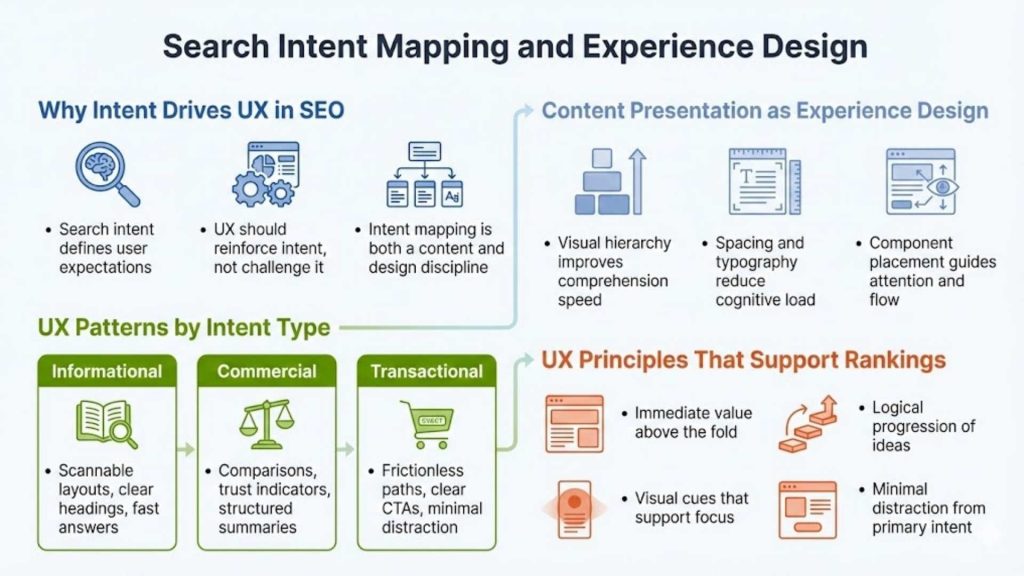
UX Patterns Aligned with Intent Types
Different intentions require different experiences. Informational queries benefit from scannable layouts, clear headings, and fast access to answers. Commercial investigation queries require comparison frameworks, trust indicators, and structured summaries. Transactional queries demand frictionless paths to action.
Failure to align UX with intent often explains why strong content underperforms. Users may find the information accurate but inaccessible or exhausting to consume. This is a core reason why ux design is important for seo at an advanced level.
Content Presentation as Experience Design
Content structure directly influences engagement. Visual hierarchy, spacing, typography, and component placement all affect comprehension speed and retention. UX and SEO share a common goal here: reduce effort while increasing clarity.
Effective user experience optimization in content design focuses on:
- Immediate value delivery above the fold
- Logical progression of ideas
- Visual cues that guide attention
- Minimal distraction from the primary intent
Search engines increasingly reward pages that deliver this clarity consistently across queries and devices.

Technical UX as a Foundation for SEO Performance
Technical performance defines whether users can access the experience at all. No amount of design sophistication compensates for slow rendering, unstable layouts, or unresponsive interfaces, especially when core on-page execution is neglected. Technical UX sits at the core of seo and ux design execution. As of late 2025, as stated from SE Ranking only 54.6% of websites meet Core Web Vitals benchmarks across speed, interaction, and layout shift. This highlights how many businesses still miss the mark on performance UX, and the SEO penalties that come with it.
Performance and Perceived Speed
Perceived speed matters as much as actual load time. Techniques such as resource prioritization, font optimization, and lazy loading improve how quickly users feel in control. These improvements reduce abandonment and reinforce positive engagement signals.
From an SEO perspective, performance consistency matters more than isolated scores. Pages that load reliably across devices and networks earn greater trust from both users and algorithms.
JavaScript, Rendering, and Experience Integrity
Modern frameworks enable rich interactions but introduce complexity. When JavaScript delays content rendering or hides essential elements from crawlers, SEO suffers. UX teams and SEO specialists must collaborate to ensure enhancements remain accessible and indexable.
This collaboration exemplifies seo ux design at its most technical level. Decisions about rendering strategies, hydration, and component loading directly influence discoverability and experience quality.
Behavioral Metrics: How UX Impacts SEO Through User Signals
Search engines increasingly rely on user behavior to interpret experience quality. While they do not directly report on every interaction metric, the correlation between behavioral patterns and SEO outcomes is well-established. Understanding how UX impacts SEO at this level helps marketers prioritize meaningful engagement over surface-level design.
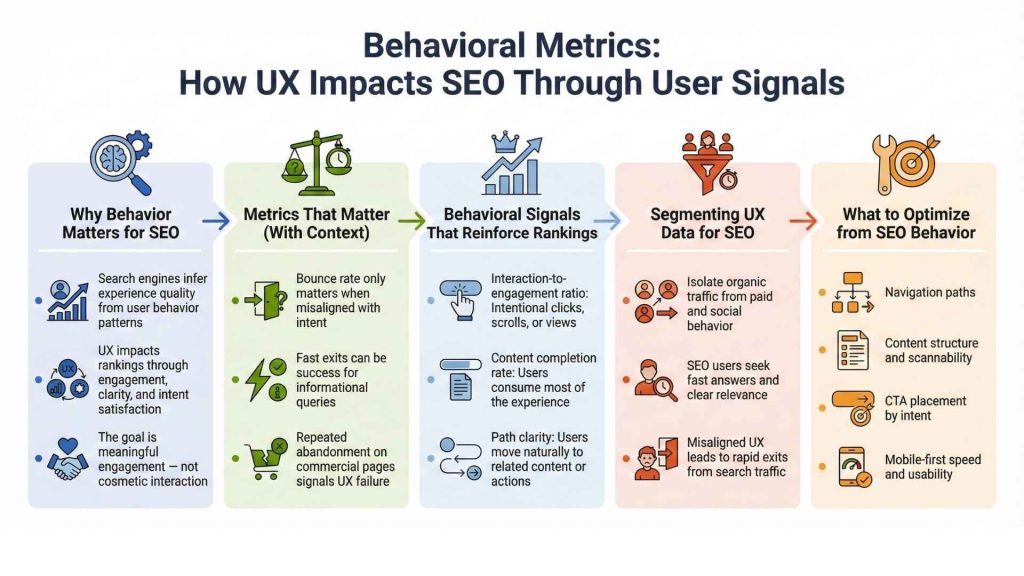
Measuring Behavior with SEO in Mind
Standard UX metrics like bounce rate, time on page, or scroll depth only provide value when contextualized. A high bounce rate does not always indicate a problem. For an informational query, a user may find exactly what they need and leave quickly. However, if that behavior occurs across content designed for commercial or transactional outcomes, it may signal a UX failure.
From an SEO UX perspective, meaningful metrics include:
- Interaction-to-engagement ratio: Are users clicking, watching, or scrolling with intent?
- Content completion rate: Do users consume the majority of the experience?
- Path clarity: Do users follow intuitive paths to additional content or actions?
Each of these reflects how user experience affects SEO by reinforcing or undermining search engines’ confidence in the page’s ability to serve intent.
Segmenting by Traffic Source
To understand user experience optimization specifically in relation to search, marketers must isolate organic traffic. User behaviors from paid, social, or direct channels carry different expectations. Organic users often land on deeper pages, seek answers quickly, and leave if the experience does not feel aligned with the query.
Analyzing user flows from SEO specifically allows for focused improvements in:
- Navigation paths
- Content structure
- CTA placement
- Page speed in mobile-first contexts
UX in SEO depends on this kind of segmentation to avoid broad, ineffective optimization efforts.
Ecommerce Case: Tools for SEO and UX Optimization in Ecommerce
Nowhere is the connection between SEO and UX more tangible than in ecommerce. Every click, scroll, and purchase represents not only a revenue opportunity but also a data point that influences search visibility. For this reason, the right tools for SEO and UX optimization in ecommerce are essential to scale performance.
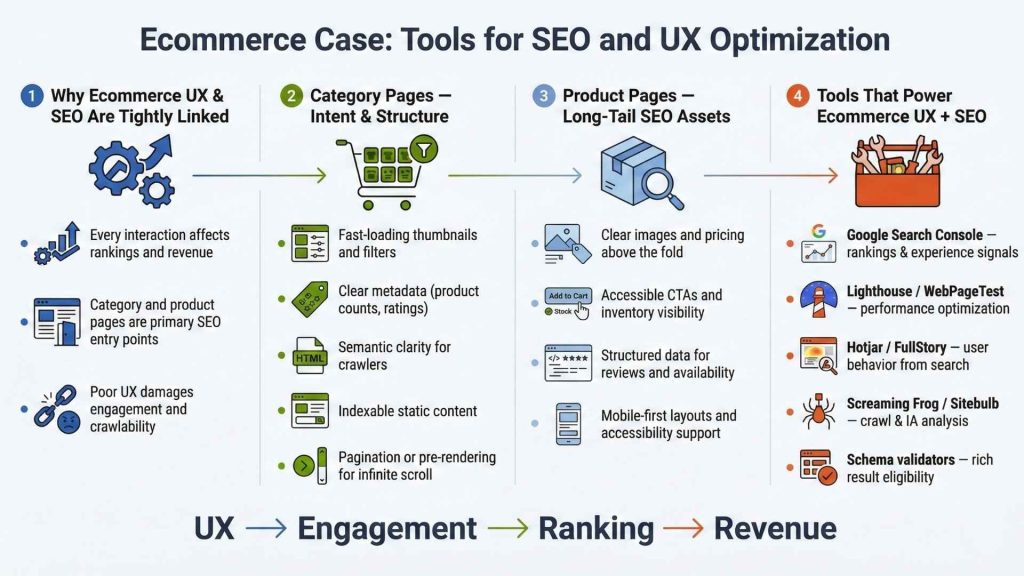
Category Page Design and Intent Alignment
Category pages often act as high-traffic entry points from long-tail and category-level queries, making them essential for scaling ecommerce performance through organic traffic. A poor UX here will damage both engagement and crawlability. Ecommerce UX design must:
- Provide fast-loading thumbnails and filters
- Surface meaningful metadata (e.g., product counts, ratings)
- Enable semantic clarity for crawlers
- Embed indexable, static content without blocking access
SEO UX design on category pages demands both technical execution and visual logic. Infinite scroll, if not properly handled with pagination or JavaScript pre-rendering, can hinder discoverability and frustrate users.
Product Pages as Long-Tail SEO Assets
Each product page is a micro-experience. For long-tail search queries, these pages often serve as the first interaction point with a brand. If the experience is cluttered, slow, or lacks trust signals, the user exits and the SEO value diminishes.
Optimized product UX design should include:
- Clear above-the-fold images and pricing
- Accessible CTAs with real-time inventory info
- Structured data for reviews and availability
- Mobile-specific layout testing
- Accessible markup for screen readers
Failure at this level is costly. The bounce impacts SEO. The lost sale impacts ROI.
Tools That Power Ecommerce UX and SEO Integration
Ecommerce teams should use a blend of UX research and SEO analytics tools. Some of the most effective combinations include:
- Google Search Console for experience and ranking diagnostics
- Lighthouse and WebPageTest for performance tuning
- Hotjar or FullStory to observe user flows from search
- Screaming Frog or Sitebulb for IA and crawl optimization
- Schema.org validators to ensure rich snippet eligibility
Together, these tools show how UX design and SEO must operate within a unified system. Fixes that improve one without considering the other often lead to regressions in conversion or ranking.
Semantic SEO and UX: Entity‑Driven Experience Design
Semantic optimization is one of the most underexplored connections between UX and SEO. While competitors focus heavily on layout, speed, and usability heuristics, fewer address how semantic structure influences user experience and ranking behavior at the same time.
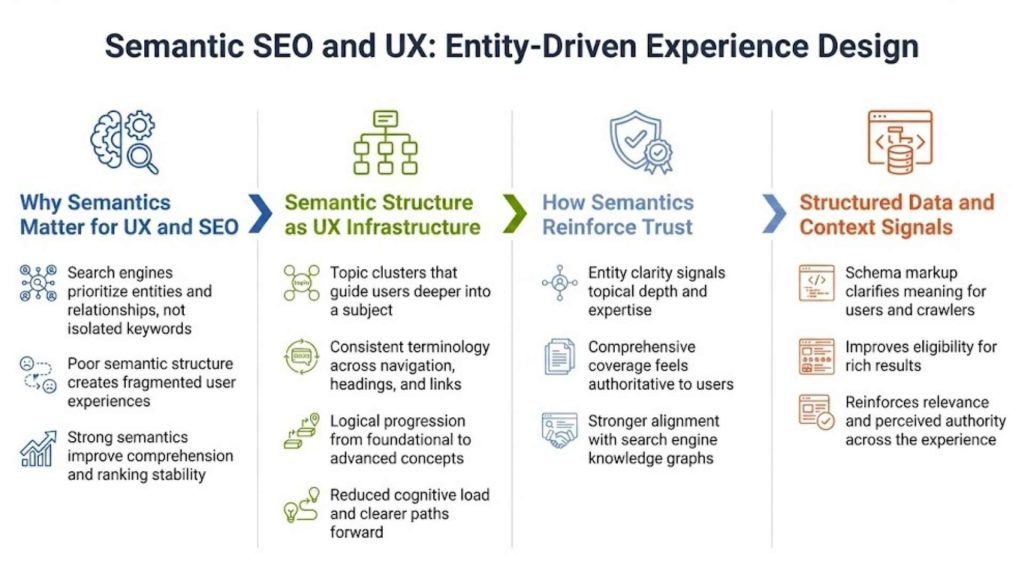
Search engines increasingly rely on entities, relationships, and contextual understanding rather than isolated keywords, driven by machine-led interpretation of meaning and relevance. UX design that ignores semantic structure often creates experiences that feel fragmented or incomplete, even when the content itself is strong.
Semantic Structure as UX Infrastructure
Semantic SEO improves UX by making content easier to navigate, interpret, and explore. When pages are structured around clear topics, subtopics, and relationships, users spend less cognitive effort figuring out where they are and what to do next.
Examples of semantic UX alignment include:
- Topic clusters that guide users through progressively deeper information
- Consistent terminology across navigation, headings, and internal links
- Logical progression from foundational concepts to advanced insights
These patterns support both user comprehension and search engine understanding. This is a direct example of how ux design and seo reinforce each other at a structural level.
Entities, Context, and Trust Signals
Entity-based optimization helps search engines connect your content to broader knowledge graphs. From a UX perspective, this same structure builds trust. Users recognize when a site demonstrates comprehensive understanding rather than surface-level coverage.
Structured data, schema markup, and consistent entity references improve eligibility for rich results while clarifying meaning for users. This alignment strengthens relevance signals and enhances perceived authority across the experience.
Intent‑Driven UX Mapping Across the Search Funnel
One of the most effective ways to outperform competitors is to move beyond static intent matching and design experiences that evolve with the user’s position in the search funnel. UX in SEO becomes significantly more powerful when intent mapping is applied dynamically rather than at the page level alone.

UX Patterns by Intent Type
Different search intents require fundamentally different UX approaches:
- Informational intent: Prioritize clarity, scannability, and rapid value delivery
- Commercial investigation: Enable comparison, evidence, and validation
- Transactional intent: Remove friction, surface CTAs, and reinforce trust
- Navigational intent: Provide immediate access with minimal distraction
When UX design fails to reflect intent, users disengage quickly. This creates negative behavioral signals that undermine rankings. This is a core reason why ux design is important for seo in competitive SERPs.
Funnel‑Aware Experience Design
Advanced SEO UX strategies map UX components across the funnel rather than isolating them per page. For example, informational content should naturally lead to investigative resources, while commercial pages should anticipate transactional needs without forcing them prematurely.
This approach improves:
- Session depth
- Internal linking effectiveness
- Conversion readiness
- Search engine confidence in content relevance
Intent-driven UX mapping directly addresses how ux impacts seo beyond rankings, influencing lifetime value and brand authority.
Progressive Web Experience Strategies for SEO and UX
Modern search and UX optimization have outgrown the static web. Today’s most competitive websites embrace progressive web experience (PWE) strategies to deliver fast, resilient, and intent-aligned experiences across devices, environments, and network conditions. This evolution impacts both user satisfaction metrics and the technical signals that underpin SEO performance.

Perceived Performance: The New First Impression
Search engines now consider real user experience signals such as Interaction to Next Paint (INP) and Largest Contentful Paint (LCP). However, user perception begins before those metrics are even fully measurable. When a page starts loading, users expect instant feedback, not blank screens or jarring layout shifts.
Progressive web experience design addresses this by optimizing perceived performance, not just measurable speed. Techniques like skeleton loading states, critical CSS delivery, and progressive image enhancement create a feeling of responsiveness even when full resources haven’t loaded yet. From a UX perspective, this builds user trust. From an SEO lens, it reduces early abandonment and reinforces engagement signals that impact ranking.
Resilience and Offline UX
PWEs also consider degraded environments. Through service workers, developers can enable caching, offline modes, or background synchronization. This creates reliability, especially for mobile-first users or global audiences with inconsistent connectivity. When users feel confident that your experience won’t break under stress, they stay longer and return more often. These behavioral patterns boost session metrics that influence long-term search performance.
This resilience improves user experience optimization holistically. Fewer technical interruptions mean fewer bounce triggers, fewer support costs, and higher SEO velocity through behavioral reinforcement.
SEO Considerations with Progressive Technologies
Progressive enhancement must be implemented carefully to avoid undermining crawlability. Sites using single-page applications (SPAs) or client-side JavaScript rendering can easily obstruct critical SEO elements if rendering paths are not optimized.
To align SEO and UX through PWEs:
- Use server-side rendering (SSR) or hydration to ensure content is visible to bots
- Avoid hiding navigational or keyword-rich content behind interactive states
- Serve semantic HTML and crawlable links by default
- Prioritize mobile-first progressive design patterns, since Google primarily indexes mobile UX
When implemented correctly, progressive strategies deliver powerful, crawl-safe experiences that satisfy both users and search engines.
Accessibility as a Strategic SEO and UX Advantage
Accessibility is often treated as a compliance requirement or corporate social responsibility initiative. In reality, it is one of the most underutilized competitive advantages in the intersection of UX and SEO. Designing for accessibility inherently enhances usability for all users and helps search engines understand content hierarchy and relevance more clearly.
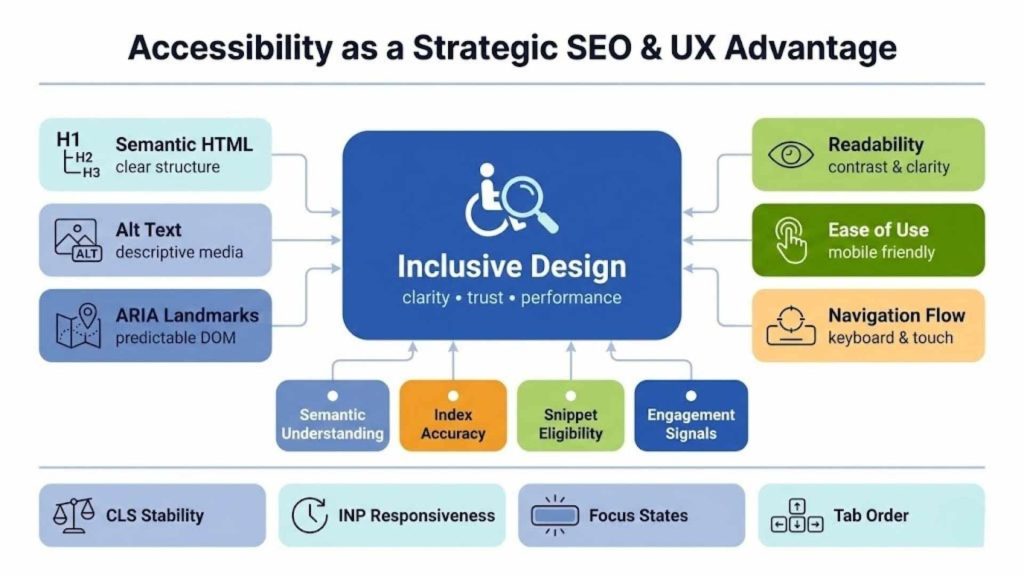
Accessibility and Organic Visibility
Search engines prefer well-structured, semantically rich HTML. Accessible design mandates this very structure. Pages that follow proper heading hierarchy, use descriptive alt text, and implement ARIA landmarks not only work better for screen readers, but also for search bots that depend on clean, predictable DOM trees.
Accessibility improvements enhance:
- Semantic understanding: Better HTML structure leads to clearer contextual interpretation by crawlers
- Indexing accuracy: Accessible content is more likely to be correctly indexed and ranked
- Featured snippet eligibility: Accessible, clearly structured answers are more extractable for SERP features
- Reduced bounce from assistive-device users: Longer engagement sessions improve UX and SEO feedback loops
By aligning accessibility with SEO UX design, you remove friction points that create exit signals and improve technical compliance that search engines reward.
Inclusive Design = Better UX = Better SEO
Accessible design benefits everyone, not just users with impairments. Clean contrast ratios improve readability in sunlight. Larger tap targets help mobile users with one-handed operation. Text alternatives on media help those in sound-off environments. These improvements directly reduce frustration and abandonment.
This is how user experience affects SEO in ways often overlooked: when inclusive design reduces struggle, users stay longer, click deeper, and complete more goals. Search engines interpret these behaviors as trust signals.
Accessibility and Core Web Vitals
Many accessibility best practices align with Google’s performance expectations. For example:
- Avoiding layout shifts (CLS) benefits users with cognitive or visual impairments
- Prioritizing input responsiveness (INP) benefits users with motor challenges
- Clear focus states and tab orders enhance both interaction and bot understanding
By embedding accessibility into every phase of design and SEO implementation, you unlock compounding benefits across search, engagement, and retention.
AI Search, AEO, and the Future of UX in SEO
AI-powered search is redefining how content is discovered, interpreted, and surfaced, particularly in generative search environments. The rise of Answer Engine Optimization (AEO), entity-based search, and zero-click experiences demands a new understanding of how UX in SEO must evolve to remain effective.
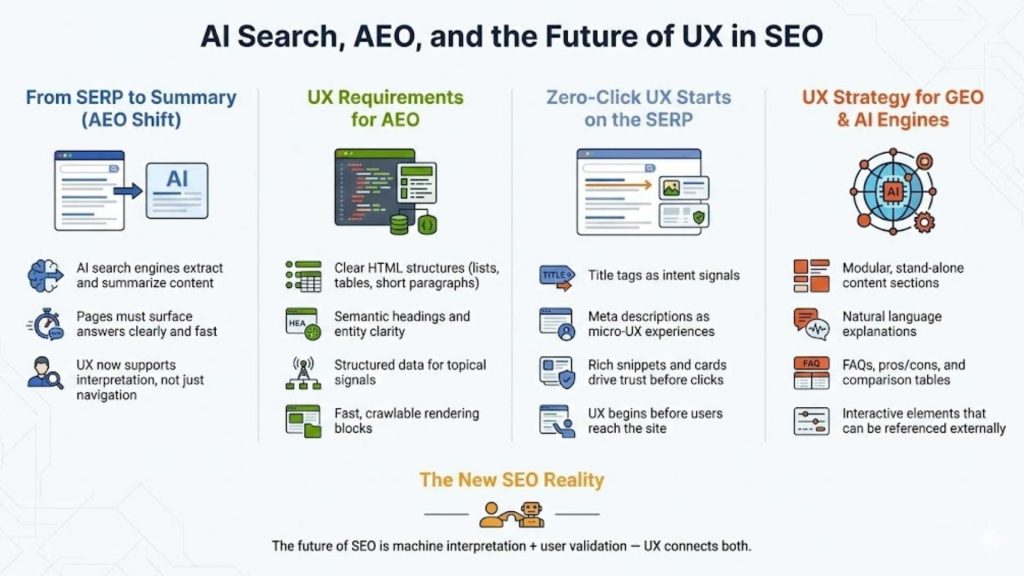
From SERP to Summary: The AEO Paradigm
Answer Engine Optimization focuses on how content is selected and summarized by AI agents such as Google’s Search Generative Experience (SGE), Bing’s ChatGPT integrations, and voice assistants. These engines don’t just rank pages, they extract and synthesize answers from them.
This has massive implications for UX and SEO. Pages must be structured to:
- Surface answers within clear HTML elements (e.g., paragraphs, lists, tables)
- Use structured data and semantic headings to signal topical segments
- Optimize for entity clarity rather than keyword density
- Ensure fast rendering, as AI engines often prioritize crawlable and parseable content blocks
In this environment, UX and SEO must work together to design experiences that front-load value, streamline interpretation, and support summarization.
Zero-Click UX and On-SERP Engagement
As search interfaces evolve to deliver more answers without clicks, websites must treat the search results page itself as part of the user experience. A compelling title tag, structured snippet, and rich media preview can determine whether a user ever visits your page.
To compete:
- Treat meta descriptions as micro-UX experiences
- Use structured markup to qualify for featured snippets and rich cards
- Design title formats that reflect intent and promise clarity
- Include content teasers that deliver stand-alone value while encouraging deeper engagement
UX in SEO now begins before the user even lands on your site. Winning attention and trust on the SERP is now a critical experience layer.
UX Strategy in the Age of AI and GEO
Generative Engine Optimization (GEO) introduces the challenge of optimizing for machines that write summaries, not just index content. These AI engines use content fragments to answer multi-intent queries. The clearer your UX, the more usable your content becomes to those systems.
Strategies include:
- Breaking complex answers into modular, standalone sections
- Using natural language structure that mimics human explanations
- Including FAQs, pros/cons tables, and authoritative language without jargon
- Designing interactive UX elements that can be embedded or referenced externally
The future of SEO is machine interpretation + user validation. Your UX determines whether AI finds your content usable, and user behavior determines whether the result remains visible.
Collaboration Models: Integrating SEO and UX Design Teams
Despite the strategic overlap, many organizations still separate UX and SEO teams. This results in disjointed workflows, missed opportunities, and designs that unintentionally suppress visibility or engagement. Resolving this conflict requires process redesign and a culture shift.
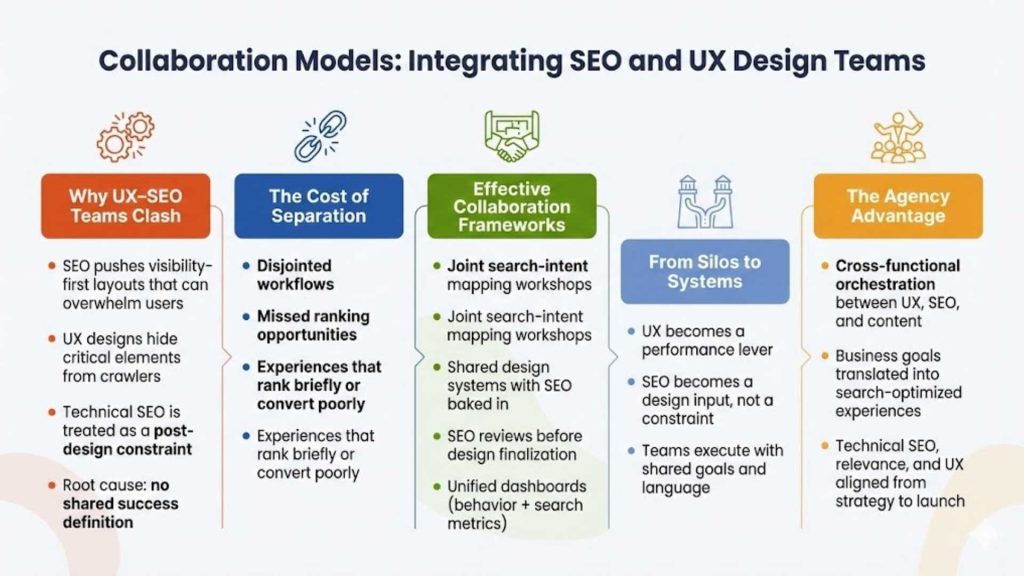
Common Conflicts and Their Root Causes
- SEO teams prioritize keyword-rich layouts that overwhelm users
- UX designers create elegant experiences that hide critical elements from crawlers
- Technical SEO recommendations are viewed as post-design constraints instead of inputs
These misalignments result from lack of shared goals. The key to resolving this is mutual understanding of how UX design and SEO intersect in the user journey.
Effective Collaboration Frameworks
To succeed, both disciplines must contribute from strategy through launch. Recommended practices include:
- Joint intent mapping workshops to align on user goals
- Shared design systems with built-in SEO considerations
- Review protocols where SEO teams vet designs before finalization
- Unified dashboards tracking behavior and search metrics side by side
When teams adopt these models, UX design becomes a performance asset rather than a creative silo. This represents the evolution from fragmented efforts to holistic seo and ux design execution.
The Agency Advantage
Creative agencies, especially those focused on performance-driven design, can bridge the UX and SEO gap. Agencies like RiseOpp work with both design and organic growth teams to translate business goals into search-optimized experiences. Their cross-functional processes ensure that technical SEO, content relevance, and experience design are built into every layer of digital delivery.
Forecasting ROI: Why Is UX Design Important for SEO Long-Term?
Some teams underestimate the long-term value of investing in UX for SEO because it doesn’t always produce immediate ranking jumps. However, the compounding effect over time is undeniable. Optimized experiences lead to stronger links, higher engagement, and sustained rankings. Each of these contributes to increased revenue and brand equity.
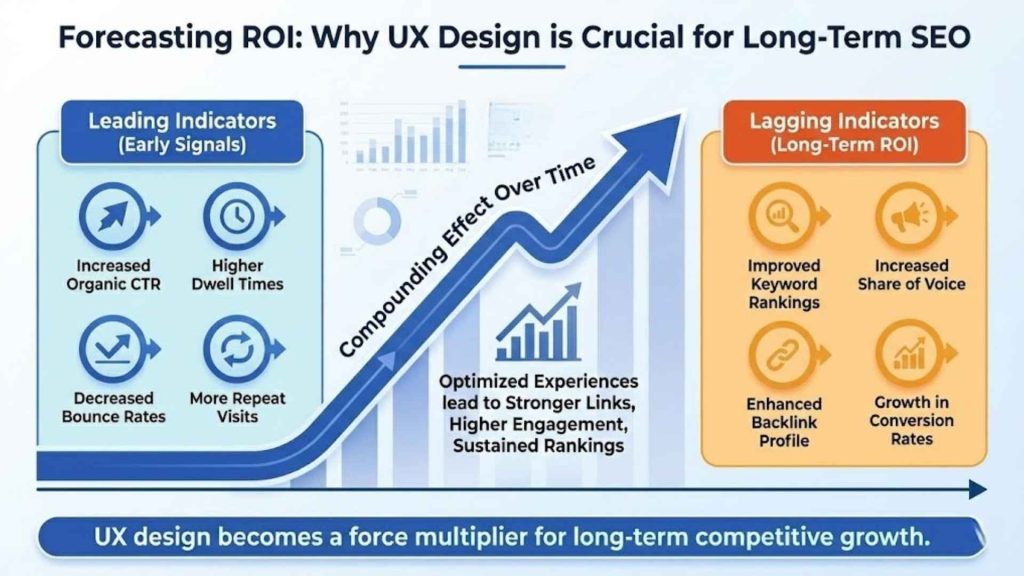
Leading Indicators of UX-Supported SEO Growth
- Increased organic CTR from improved page presentation in SERPs
- Higher dwell times and deeper session paths from reduced friction
- Decreased bounce rates for key commercial pages
- More repeat visits and branded search volume over time
These outcomes are often early signals that user experience optimization is enhancing search performance.
Lagging Indicators That Show ROI
- Improved keyword rankings, especially for competitive mid-funnel terms
- Increased share of voice in featured snippets and rich results
- Enhanced backlink profile due to linkable UX components (tools, calculators, interactive demos)
- Growth in conversion rates from organic sessions
These are the metrics that build over quarters, not weeks. They show why is ux design important for seo beyond short-term technical fixes. UX design becomes a force multiplier across content marketing, technical SEO, and CRO simultaneously, supporting long-term competitive growth through experience.
Preparing for What’s Next: The Future of SEO and UX
The relationship between SEO and UX is evolving rapidly. As search engines become more intelligent and users demand faster, cleaner, and more meaningful experiences, the overlap between user experience optimization and organic visibility is becoming deeper and more strategic. The future of UX in SEO is not about adapting to isolated ranking updates; it’s about designing systems that align with how people search, think, and interact across platforms.
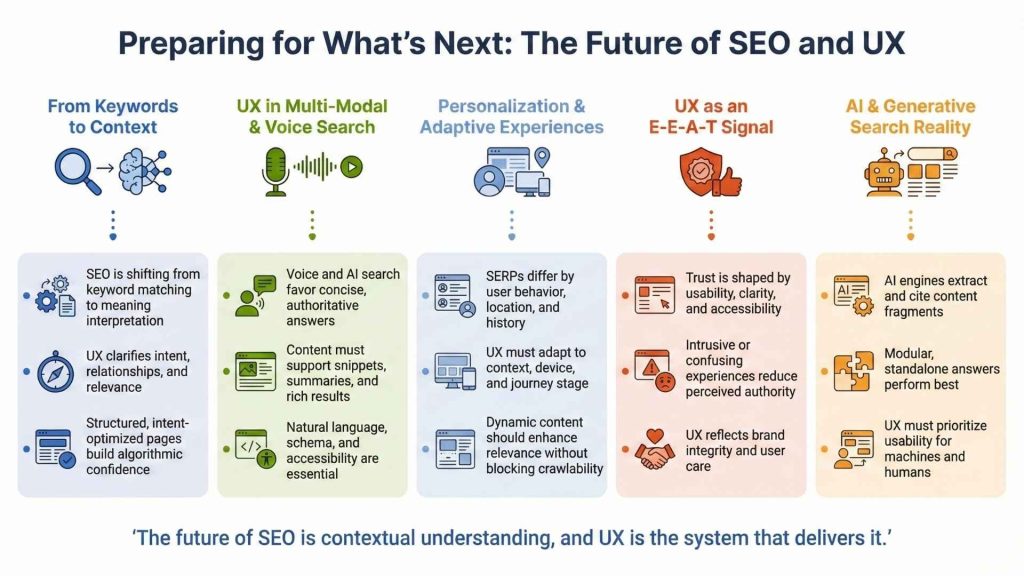
The Shift from Keywords to Context
Historically, SEO strategies focused on keywords and backlinks. While these fundamentals still matter, their weight is shifting toward contextual and semantic signals. Google’s advancements in Natural Language Processing (like BERT and MUM) allow it to evaluate the quality of answers, not just the presence of target phrases.
UX plays a central role in providing that context. A well-structured, intent-optimized page with strong visual hierarchy and accessible content not only improves comprehension but also boosts search engines’ confidence in the page’s value. As algorithms move from keyword matching to meaning interpretation, UX becomes an integral ranking lever.
Expect the future of search to prioritize:
- Content structured around user tasks and goals, not arbitrary keyword counts
- Entity-first indexing, where design and UX clarify relationships between topics
- Experiences that minimize friction at every level, from search to conversion
UX for Multi-Modal and Voice-Driven Search
The search landscape is diversifying. Users increasingly access content via voice assistants, smart devices, and non-traditional interfaces. This introduces new UX challenges, and opportunities, for visibility.
For instance:
- Voice queries tend to be longer, more conversational, and often imply strong intent
- Results must be concise, authoritative, and formatted for natural language summarization
- Mobile and wearable searches rely on touchless UX, with screenless outputs or minimal interfaces
To compete in this environment, content must be:
- Structured for Featured Snippet and rich result eligibility
- Written in natural, question-and-answer formats
- Built on semantic markup and schema.org standards
- Accessible and intuitive even with limited UI
These shifts reinforce the need to view SEO and UX not as siloed disciplines, but as co-architects of content delivery across ecosystems.
Personalized Search and Experience Differentiation
As search engines personalize results based on location, behavior, and previous interactions, two users searching for the same query may see entirely different SERPs. This personalization increases the pressure on marketers to ensure UX is not just generally good, but also contextually relevant.
Future UX in SEO must address:
- Behavioral adaptation: Site experiences that respond to repeat visits, device preferences, and inferred user stages
- Dynamic content blocks that serve personalized CTAs, recommendations, or learning paths
- Predictive UX design, where design choices anticipate what the user needs next based on data
This does not mean sacrificing crawlability for dynamic personalization. Instead, it means using SEO-safe dynamic elements that support relevance without hiding content from bots.
UX-Driven Brand Equity and E-E-A-T Signals
Google’s continued emphasis on E-E-A-T (Experience, Expertise, Authoritativeness, and Trustworthiness) has far-reaching implications for UX strategy. While much of E-E-A-T is tied to content and author credibility, experience quality plays a subtle but powerful role.
Design patterns, interaction models, and layout structure contribute to a user’s perception of credibility. For instance:
- Pages with intrusive ads or manipulative dark patterns reduce trust
- Sites that are hard to navigate may be seen as less authoritative
- Poor mobile or accessibility performance reflects negatively on user care
UX becomes a signal of brand integrity. Sites that deliver consistently high-quality, frictionless experiences, across informational and transactional content, will be rewarded with stronger engagement metrics and more favorable algorithmic interpretations.
AI and Generative Search: The Strategic Imperative
As outlined in the previous section on AEO, AI-powered search engines like Google SGE and Bing Chat are changing the nature of discoverability. These systems don’t just list results, they synthesize answers, pulling from various sources and prioritizing clarity, structure, and factual reliability.
Future-proof UX and SEO must adapt to:
- Designing for fragment-based extraction, where sections of your content are selected and cited out of context
- Optimizing modular content that answers questions independently within a page
- Structuring content with explicit answers, supporting context, and follow-up pathways
To compete in generative environments, UX design must increase information usability, not just information availability.
Why UX in SEO Matters for Rankings, Revenue, and Retention
User experience is no longer a secondary consideration in search strategy; it’s a core driver of performance across every dimension that matters: rankings, revenue, and customer retention. The evolution of Google’s algorithms and the increasing sophistication of users have reshaped the role of UX in SEO. It’s not just about making a site usable; it’s about aligning the experience with intent, reducing friction, and guiding users toward the outcomes they came for.

UX Signals Reinforce Search Rankings
Search engines don’t rank content in a vacuum. Google’s systems measure how users interact with pages and reward those that deliver on intent efficiently. Pages that satisfy user expectations tend to enjoy stronger dwell time, deeper engagement, and lower bounce or pogo-sticking rates, patterns that consistently appear in real-world organic growth outcomes. These behavioral signals send a clear message: this result met the user’s needs.
When a site offers a clean, fast, and intuitive experience, especially on mobile, users are more likely to stay, engage, and explore. These behaviors contribute to ranking durability, even in competitive verticals. This is why UX in SEO matters so much for keyword stability over time. High-performing content without supporting UX will eventually lose ground to competitors that offer a better overall experience.
Additionally, with Core Web Vitals now integrated into the ranking algorithm, UX performance metrics like Largest Contentful Paint (LCP), Interaction to Next Paint (INP), and Cumulative Layout Shift (CLS) directly influence visibility. Sites that ignore these experience-based metrics are leaving SEO performance on the table.
Revenue Growth Through Experience-Driven Conversion
A good user experience is also a sales enabler. Research from Lumar (formerly Deepcrawl) indicates that a 1-second delay in page load time can result in a 26% drop in conversions. In high-traffic SEO environments, that margin is significant, especially when user trust and action are earned in milliseconds.
.When users land on a page that’s aligned with their intent, structured for readability, and optimized for speed, they’re more likely to take meaningful action, whether that’s filling out a lead form, signing up for a demo, or completing a purchase.
- Clear navigation and content hierarchy reduce hesitation
- Trust signals and smooth interaction design increase conversion rates
- A responsive mobile layout ensures accessibility across key buyer moments
- Fast-loading, distraction-free interfaces reduce drop-off mid-funnel
UX contributes directly to conversion efficiency across the organic channel. The more seamless and intuitive the path from entry to action, the more revenue a brand can drive from its SEO investment. This is why user experience optimization is not just a usability function, it’s a revenue function.
Retention and Long-Term Value
Most SEO strategies focus on acquisition, but UX in SEO is critical for retention as well. When users enjoy a search journey that leads them to value without frustration, they’re more likely to return. Repeat engagement is one of the strongest organic signals you can generate, both for Google and for your business.
UX elements that increase retention include:
- Personalized content modules based on previous behavior
- Clear pathways to deeper, related content
- Fast-loading dashboards or account areas for logged-in users
- Mobile-first experiences that remember preferences across sessions
These are not just design features, they are strategic UX layers that drive engagement metrics and influence search visibility through behavioral reinforcement.
Benefits of Strong UX in SEO
To summarize, here are the most important benefits brands can expect when they integrate UX into their SEO strategy:
- More stable keyword rankings through reduced bounce and intent fulfillment
- Higher click-through rates (CTR) due to better SERP presentation and snippet formatting
- Deeper session paths enabled by logical navigation and structured content
- Increased conversion rates from frictionless, intent-aligned page experiences
- Greater eligibility for featured snippets, People Also Ask boxes, and AI-generated answers
- Improved Core Web Vitals and mobile usability scores, boosting ranking signals
- More repeat visitors, stronger branded search behavior, and greater retention over time
In competitive SERPs, UX in SEO is often the true differentiator between pages that briefly appear and those that dominate long term. The winners aren’t always those with the most backlinks or even the most content; they’re the ones that match user expectations and guide them effortlessly toward their goals.
In the age of AI-powered search and experience-based ranking, investing in UX as a core component of SEO strategy is no longer optional, it’s essential for any business that wants to grow sustainably through organic search.
Frequently Asked Questions (FAQ)
Is UX a direct ranking factor in Google’s algorithm?
Google does not treat UX as a single, direct ranking factor. Instead, it evaluates a combination of experience-related signals, such as Core Web Vitals, mobile usability, page load performance, and certain behavioral indicators, to assess page quality. These signals work collectively rather than as a single weighted switch. While strong UX won’t automatically boost rankings, poor UX can undermine even well-optimized content.
Can improving UX alone help a site recover from a ranking drop?
It depends on the root cause. If a ranking drop stems from technical issues, spam signals, or algorithmic penalties, UX improvements alone will not restore performance. However, if declines align with negative engagement patterns, such as pogo-sticking or reduced dwell time, addressing UX factors like speed, navigation clarity, and readability can help rebuild trust with users and algorithms over time.
How should SEO and UX teams collaborate during a redesign or replatforming?
SEO and UX teams should collaborate from the start, not as a final-stage handoff. Effective collaboration includes:
- Joint intent mapping to align user journeys with search demand
- Shared data analysis (heatmaps, scroll maps, bounce rates, query data)
- Coordinated site architecture planning to preserve SEO equity while improving usability
- Prototype testing that accounts for both UX KPIs and SEO accessibility
Many post-launch SEO issues arise when UX-driven changes overlook crawlability, internal linking, or on-page fundamentals.
Do Core Web Vitals impact rankings across all devices equally?
No. Core Web Vitals are primarily measured on mobile devices due to mobile-first indexing. Poor mobile performance can negatively affect rankings even if desktop performance is strong. This makes mobile UX, such as tap targets, font legibility, and loading behavior, critical for meeting Core Web Vitals thresholds and protecting search visibility.
What are the most common UX mistakes that harm SEO?
Common UX-related decisions that negatively impact SEO include:
- Hiding important content behind tabs or accordions without indexing considerations
- Using infinite scroll without crawlable pagination
- Removing internal links for minimalist design reasons
- Prioritizing aesthetics over accessibility and semantic structure
- Deploying intrusive interstitials or aggressive pop-ups
These issues can reduce crawl efficiency, weaken engagement signals, and prevent key content from being indexed.
Is there a difference between CRO (Conversion Rate Optimization) and UX in SEO?
Yes. CRO focuses on increasing specific conversion actions through testing and behavioral analysis. UX in SEO is broader, encompassing the entire journey from SERP click to on-site interaction and intent fulfillment. A CRO change may improve conversions but still harm SEO if it degrades load time, content clarity, or accessibility. The two disciplines should be aligned but not treated as interchangeable.
How does UX influence Featured Snippets and AI-generated answers?
Search engines favor content that is easy to extract and interpret, such as lists, tables, concise paragraphs, and clear headings. UX that supports scannable, modular content and surfaces direct answers early on increases eligibility for Featured Snippets, People Also Ask results, and AI-generated summaries from systems like Google SGE or Bing Chat.
Can UX design help with E-E-A-T (Experience, Expertise, Authoritativeness, Trustworthiness)?
Yes. UX reinforces E-E-A-T signals in several ways:
- Clean, professional design builds trust
- Author pages and contributor bios signal expertise
- Clear navigation and logical structure support authority
- Testimonials, support access, and transparency enhance trust
Poor UX can undermine perceived expertise, regardless of content quality.
How often should UX be reviewed as part of an SEO strategy?
UX should be reviewed continuously, with focused audits:
- After major algorithm updates targeting user satisfaction
- During redesigns, migrations, or platform changes
- When organic performance plateaus or declines
- As new interaction patterns emerge (e.g., AI-driven search, mobile behavior)
Ongoing monitoring of metrics like scroll depth, INP, mobile usability, and landing-page engagement is essential. UX is not a one-time fix, it’s a living component of an effective SEO system.
Final Perspective: Turning UX in SEO into a Competitive Advantage
UX in SEO is no longer a tactical enhancement; it is a strategic growth lever. Brands that integrate user experience directly into their SEO strategy achieve more stable rankings, stronger engagement, and higher conversion efficiency from organic traffic.
RiseOpp helps companies operationalize UX in SEO by aligning design, content, and technical optimization into a single performance framework. Our work goes beyond rankings or visuals; we build search-optimized experiences that convert intent into revenue.
If your organic growth has plateaued or your rankings fluctuate despite strong content, UX in SEO is likely the missing link. RiseOpp partners with teams ready to unify experience and search into one scalable advantage.
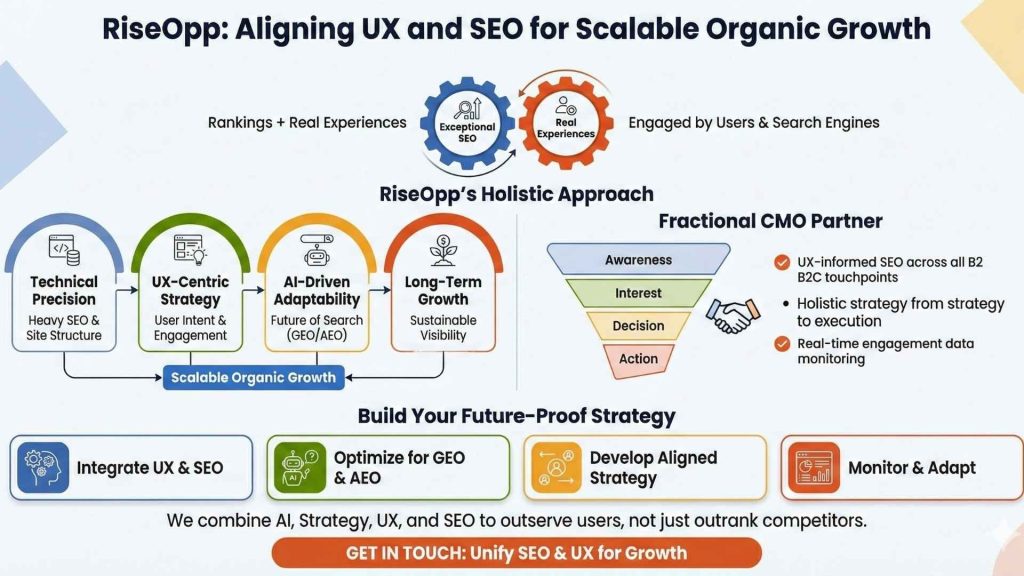
RiseOpp: Aligning UX and SEO for Scalable Organic Growth
At RiseOpp, we’ve long believed that exceptional SEO isn’t just about rankings, it’s about delivering real experiences that search engines want to reward and users want to engage with. This is why we focus so heavily on the intersection of UX and SEO in everything we do.
Whether we’re building long-term keyword visibility through our proprietary Heavy SEO methodology or designing content strategies that map directly to user intent, we approach organic growth holistically, combining technical precision, UX-centric strategy, and AI-driven search adaptability.
Through our work with B2B and B2C brands as a Fractional CMO partner, we’ve seen firsthand how UX-informed SEO accelerates every part of the marketing funnel. Our strategies account for everything from semantic structure and site architecture to content presentation and engagement signals, all through the lens of long-term organic performance.
If your team is ready to:
- Build a search strategy that integrates UX best practices and technical SEO foundations
- Optimize for the future of search through Generative Engine Optimization (GEO) and Answer Engine Optimization (AEO)
- Develop a UX-aligned content strategy and keyword strategy informed by user behavior and search intent
- Monitor performance through advanced SEO monitoring systems and real-time engagement data
…then let’s talk.
We bring together AI, strategy, UX, and deep SEO expertise to help brands grow visibility not just by outranking competitors, but by outserving users.
Get in touch with our team to explore how we can unify your SEO and UX into a modern growth strategy built for scale.
Comments are closed